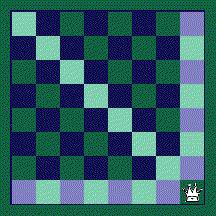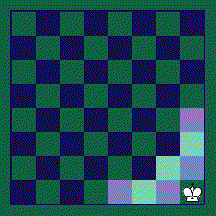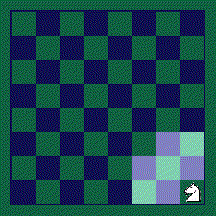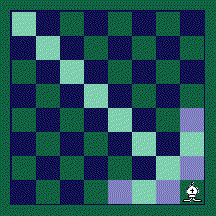Four queens on public transport
Puzzling Asked by Albert.Lang on April 12, 2021
The enlightened but, sadly, fictional country of Switzerland has it all: A strong democracy that resists centralism, a reliable public transport network and its own version of chess.
Swiss chess reflects the values of the Swiss and does not tolerate the obsession with the centre that has so discredited traditional chess. Very much as Swiss public transport does an admirable job at not letting anyone behind, any idea of peripheral real estate being inferior is firmly rejected in Swiss chess where pieces on boundary or corner squares do not suffer from reduced mobility:
Even the king of Switzerland and his entourage of bishops and knights is frequently seen hopping on the public bus to quickly navigate the realm’s more remote areas:
These are animated gifs. You may have to click on them to make them move.
Swiss rooks and pawns do not differ from ordinary rooks and pawns. And Swiss queens can move like a Swiss bishop or rook.
And here are the modified rules of movement in text form:
affected pieces: king, knight, bishop and queen (moves like a rook or bishop)
from squares where the standard pieces have maximum mobility (king: 8 squares, knight: 8 squares, bishop: 13 squares, queen: 27 squares) Swiss pieces are no different from standard pieces.
on other squares additional destinations are added to keep mobility at the set level. Exceptions: king and knight in or directly next to the corner have only 7 possible squares, queens on the edge have fewer destinations because of the overlap between rook and bishop patterns
king: a1 -> a2 a3 a4 b1 b2 c1 d1
a2 -> a1 a3 a4 b1 b2 b3 c2
a3 -> a1 a2 a4 a5 b2 b3 b4 c3
a4 : same as a3 shifted
knight: a1 -> a2 a3 b1 b2 b3 c1 c2
a2 -> a1 a3 a4 b1 b4 c1 c3
a3 -> a1 a2 a4 a5 b1 b5 c2 c4
a4 : same as a3 shifted
b2 -> a1 a3 a4 c1 c4 b1 b3
b3 -> a1 a2 a4 a5 c1 c5 d2 d4
b4 : same as b3 shifted
bishop: a1 -> a2 a3 a4 b1 b2 c1 c3 d1 d4 e5 f6 g7 h8
a2 -> a1 a3 a4 a5 a6 a7 b1 b3 c4 d5 e6 f7 g8
a3 -> a1 a2 a4 a5 a6 a7 b2 b4 c1 c5 d6 e7 f8
a4 -> a1 a2 a3 a5 a6 a7 b3 b5 c2 c6 d1 d7 e8
b2 -> a1 a3 a4 a5 c1 c3 d1 d4 e1 e5 f6 g7 h8
b3 -> a1 a2 a4 a5 a6 a7 c2 c4 d1 d5 e6 f7 g8
b4 -> a1 a2 a3 a5 a6 a7 c3 c5 d2 d6 e1 e7 f8
c3 -> a1 a5 a6 b2 b4 d2 d4 e1 e5 f1 f6 g7 h8
c4 -> a1 a2 a6 a7 b3 b5 d3 d5 e2 e6 f1 f7 g8
I’m hoping to make this a little series, so let us start off with something easy:
Can you place four queens on the board in such a way that they either occupy or threaten every square of the board?
This has many solutions. If you need to spice it up for yourself find symmetric (rotational and mirror) and non symmetric solutions.
One Answer
From what I can surmise from the Bishops rule, the following configuration of Swiss Queens should work
More Explanation
Correct answer by hexomino on April 12, 2021
Add your own answers!
Ask a Question
Get help from others!
Recent Questions
- How can I transform graph image into a tikzpicture LaTeX code?
- How Do I Get The Ifruit App Off Of Gta 5 / Grand Theft Auto 5
- Iv’e designed a space elevator using a series of lasers. do you know anybody i could submit the designs too that could manufacture the concept and put it to use
- Need help finding a book. Female OP protagonist, magic
- Why is the WWF pending games (“Your turn”) area replaced w/ a column of “Bonus & Reward”gift boxes?
Recent Answers
- Joshua Engel on Why fry rice before boiling?
- Lex on Does Google Analytics track 404 page responses as valid page views?
- Jon Church on Why fry rice before boiling?
- Peter Machado on Why fry rice before boiling?
- haakon.io on Why fry rice before boiling?



